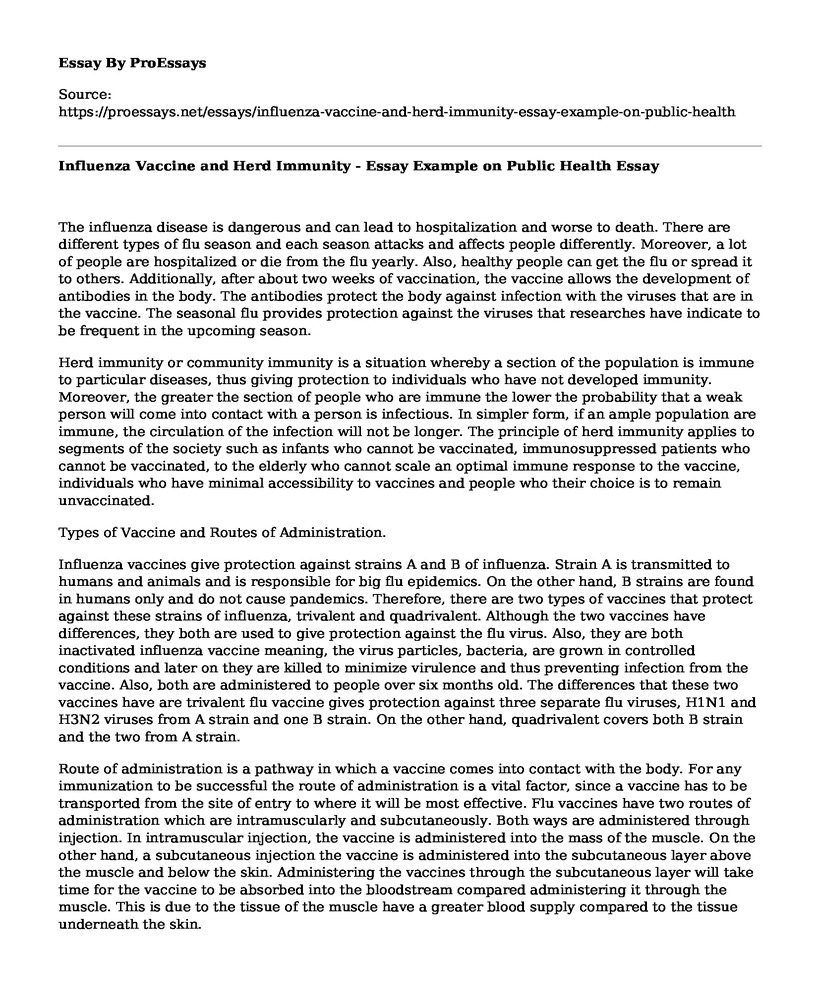The influenza disease is dangerous and can lead to hospitalization and worse to death. There are different types of flu season and each season attacks and affects people differently. Moreover, a lot of people are hospitalized or die from the flu yearly. Also, healthy people can get the flu or spread it to others. Additionally, after about two weeks of vaccination, the vaccine allows the development of antibodies in the body. The antibodies protect the body against infection with the viruses that are in the vaccine. The seasonal flu provides protection against the viruses that researches have indicate to be frequent in the upcoming season.
Herd immunity or community immunity is a situation whereby a section of the population is immune to particular diseases, thus giving protection to individuals who have not developed immunity. Moreover, the greater the section of people who are immune the lower the probability that a weak person will come into contact with a person is infectious. In simpler form, if an ample population are immune, the circulation of the infection will not be longer. The principle of herd immunity applies to segments of the society such as infants who cannot be vaccinated, immunosuppressed patients who cannot be vaccinated, to the elderly who cannot scale an optimal immune response to the vaccine, individuals who have minimal accessibility to vaccines and people who their choice is to remain unvaccinated.
Types of Vaccine and Routes of Administration.
Influenza vaccines give protection against strains A and B of influenza. Strain A is transmitted to humans and animals and is responsible for big flu epidemics. On the other hand, B strains are found in humans only and do not cause pandemics. Therefore, there are two types of vaccines that protect against these strains of influenza, trivalent and quadrivalent. Although the two vaccines have differences, they both are used to give protection against the flu virus. Also, they are both inactivated influenza vaccine meaning, the virus particles, bacteria, are grown in controlled conditions and later on they are killed to minimize virulence and thus preventing infection from the vaccine. Also, both are administered to people over six months old. The differences that these two vaccines have are trivalent flu vaccine gives protection against three separate flu viruses, H1N1 and H3N2 viruses from A strain and one B strain. On the other hand, quadrivalent covers both B strain and the two from A strain.
Route of administration is a pathway in which a vaccine comes into contact with the body. For any immunization to be successful the route of administration is a vital factor, since a vaccine has to be transported from the site of entry to where it will be most effective. Flu vaccines have two routes of administration which are intramuscularly and subcutaneously. Both ways are administered through injection. In intramuscular injection, the vaccine is administered into the mass of the muscle. On the other hand, a subcutaneous injection the vaccine is administered into the subcutaneous layer above the muscle and below the skin. Administering the vaccines through the subcutaneous layer will take time for the vaccine to be absorbed into the bloodstream compared administering it through the muscle. This is due to the tissue of the muscle have a greater blood supply compared to the tissue underneath the skin.
Cite this page
Influenza Vaccine and Herd Immunity - Essay Example on Public Health. (2021, Jun 15). Retrieved from https://proessays.net/essays/influenza-vaccine-and-herd-immunity-essay-example-on-public-health
If you are the original author of this essay and no longer wish to have it published on the ProEssays website, please click below to request its removal:
- How the CIA Created AIDS Essay
- The Pathophysiology of Atherosclerosis, and Hypertension, and Their Current Treatment Regimens
- Individuals With Disabilities Education Act Paper Example
- Essay Sample on The Impact of Family Satisfaction on the Perception of Nursing Care
- Essay Sample on Hand Hygiene
- Research Paper on Creutzfeldt Jakob Disease: Signs, Symptoms, Causes, and Diagnosis
- Advantages and Disadvantages of Plastic Surgery - Essay Sample







